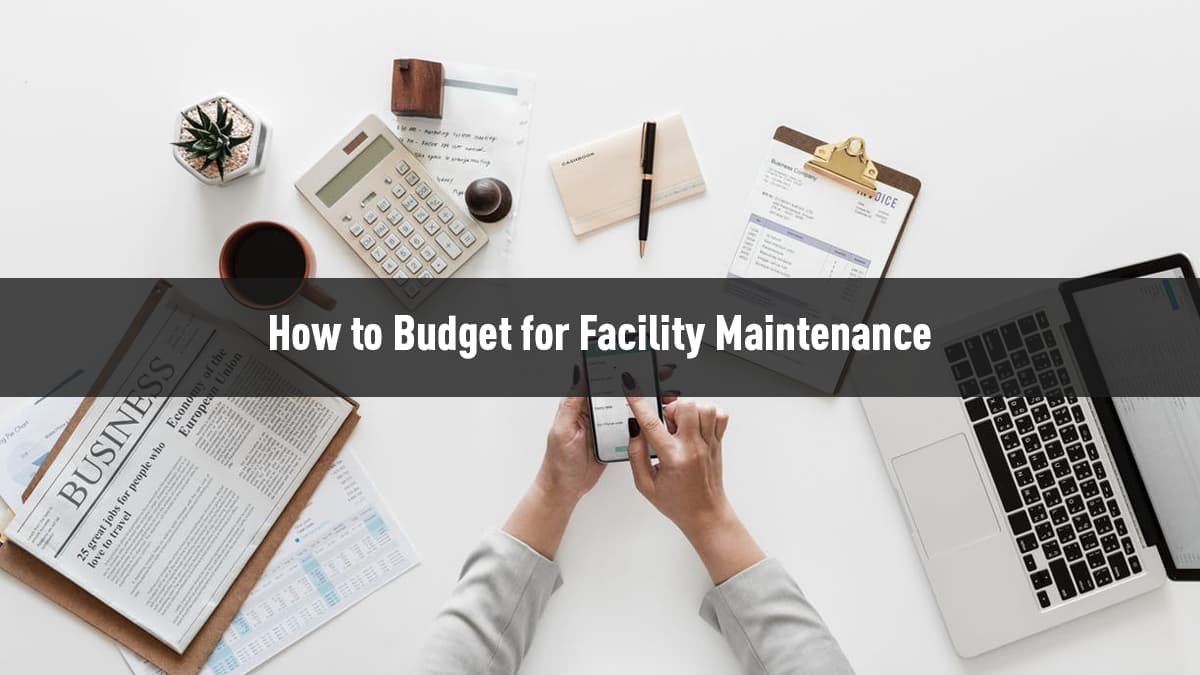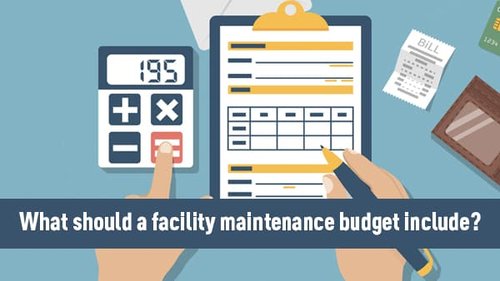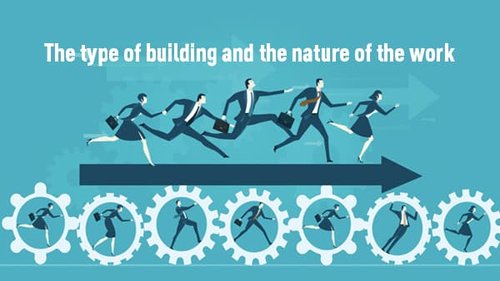
How to Budget for Facility Maintenance
When running a facility, it is necessary to take into account the amount of money spent on maintenance. From building repairs to operating maintenance costs, these costs can add up very quickly. When you own land, it is important to bear in mind the cost of ongoing maintenance and repair costs. It's not always easy to decide how much maintenance budget money. Project planning and management is one of the most challenging activities for any facility manager. Trying to pay for the cost of work at work may seem like an insurmountable challenge. However, it's one you 're going to have to tackle head-on.
There are five basic steps you can take when making a budget for building maintenance. Next, a routine treatment plan. Then analyse the life cycle of more expensive equipment. First, speak to the management to decide which capital costs are to be incurred. Put in place a contingency fund. Finally, be prepared to reassess and reassess the building over the year.
Owners should expect to make a few updates every year. They usually involve servicing of mechanical and electrical equipment, such as changing philtres and light bulbs. Any items that need to be serviced should be included in your annual budget. Although these are usually lower costs, there are higher ones that you can account for as well. For example, HVAC equipment usually has a life-cycle of 10 to 15 years, depending on how well it is handled. To keep the equipment going for as long as possible, be sure to follow the maintenance schedule for and piece of equipment. Place some regular checks on your calendar to make sure they happen during the year.
Furniture also lasts from 10 to 15 years. However, if there is a shift in style or working arrangement, businesses can be ready for change earlier. For example, work environments shifted from private offices to the original workstations several years ago. Companies are now reconfiguring their spaces to fit modern, versatile work environments and collaboration areas. Talk to your controller or CFO and President about the budget to determine how much to plan. It should include routine maintenance costs every year. However, it is important to find out if there are any significant capital expenditures coming up. Some of the items that could cause these expenses are:
- Equipment close to the end of the life cycle.
- The next renovations.
- Mergers or acquisitions, either.
- A major rise in recruiting.
If you're planning a big renovation, get your partners in early, even if it's just to build a conceptual budget. You need those numbers to prepare the adjustment in the financial plan for the next year.
There are a lot of expenditures that you can count on, but some can also surprise you. Getting a contingency fund for unexpected upgrades and repairs can be life-saving. There are a few indicators you can look for to predict when the equipment could stop working. If something leaks or smells like smoke, it may be time to replace it. Once you have a budget established, make a reassessment plan. Every six months, we suggest reviewing your building needs. At check-in, you can decide that all is working well, but taking time to ensure that you have a functioning office is vital to the success of your business as a whole.
Here are a few tips for calculating budget issues:
1. Look at the expense
Understanding how to budget facilities management begins with understanding the different costs of operating the workplace. Anything from repair costs to routine maintenance costs has an impact on how much you spend over and above your contract.
- Fixed and known costs: begin with the tabulation of your fixed costs. For example, if you know you’re spending $12,000 a year for landscaping, you can budget this as a fixed cost. Similarly, if you have access to rates from suppliers and partners for goods and services to be purchased in the coming year, budget those as established costs.
- Costs unknown and unforeseen: What is more difficult to account for are unexpected costs. There are a variety of ways to make the unpredictable more predictable. Using historical data for items such as routine maintenance costs. Depending on the accuracy of your documents, you may also look at previous years' costs and adapt them to the costs you will face.
- Seasonal and one-off expenses: It is a good idea to reduce expenses on a weekly, quarterly and annual basis. This will help to illustrate ignored expenses, such as seasonal facility fees. For example, you can pay more for electricity in the winter and more for landscaping in the summer. In the same way, if you want to schedule a renovation in the spring, you'll be able to pay certain expenses more quickly when your budget is broken down.
2. Take a look at trends
You may not have a crystal ball to say the future, but if you're up to job patterns, it may be the next best thing to do. One of the best budgeting ideas for facility managers is to look closely at job and facility management patterns and budgeting for them. Are you planning to make any improvements to your physical workplace layout this year? If that is the case, you will need to budget for each part of the project. Expanding your IoT office this year? Accounting for the costs of incorporation should be the focal point. Anything beyond the usual reach of day-to-day facility management would come at a cost. Planning is the secret to creating an equitable budget.
3. Look at the little things
Your facility management budget is complicated, but that doesn't mean it has to be intricate. Just as integrated facility management is on the rise, integrated budgeting is also critical. This means budgeting for your facilities through a variety of lenses. Take your facility management budget and break it down into individual segments. Look at the costs of operating each part of your building, and set up a plan to make the most of those dollars. For example, it can seem easy to buy light bulbs. But is this ongoing expense more than investigating a more efficient lighting solution? Forcing yourself to a scale budget also forces you to think about the cumulative elements of your workplace.
4. Create it in a buffer
Also the best budget is an unexpected expense away from being busted. Of course, that's what you're creating in a buffer. First, take the sub-budgets that are part of your overall facility budget and build in dollars for miscellaneous expenditures. This is going to give you some wiggle room at a more subtle level. For example, if you are under the budget in one region and over the budget in another, a simple switch will even things out. Alternatively, you can pay the top of your budget with one lump sum for general, unpredictable expenses. This technique offers a lump sum to deal with later on.
5. Please sell it to the C-suite
Perhaps the toughest part of the budgeting for facility management is to sell it to executives. Illustrate value whenever possible and justify the cost of benefits. If you've taken the time to prepare well and prepare appropriately for contingencies, you won't have to defend your preparation as much when you clarify. Create links from the budget to the effect they have on the workplace and keep up with the costs and figures.
Budgeting is never easy, no matter what line of work you do. There's a lot to remember for facility managers, and a lot that's unknown. The more you account for your variables, recognize trends, and build in a buffer, the more comfortable you’ll feel in your final budget.
What should a facility maintenance budget include?

The type of building and the nature of the work being done there
Routine maintenance and repair for the facility in question
Specific costs under these two headings should be taken into account for different maintenance expenditures, including those related to management, staffing and maintenance of the building. Ideally, however, the following applies to all services, irrespective of the purpose or function of the location.
The type of building and the nature of the work

First and foremost, the type of company or organisation you run will dictate how much you can spend on maintenance. For example, the amount of money spent on the upkeep of the school would be different from the amount spent by the church. On the other hand, this number should not be the budget for a facility specialising in the production of parts for advanced medical equipment.

The required budget allocation for ongoing maintenance and rehabilitation of a large inventory of facilities would usually be between two and four per cent of the overall existing replacement value of such facilities. In the absence of concrete details on which to base the budget for maintenance and repair, this amount of funding should be used as an absolute minimum amount. Where a lack of maintenance has caused a backlog of the required repairs to accumulate, the expenditure must surpass that minimum amount before the backlog has been removed.
Poor Budgeting Leads to Higher Reactive Maintenance

Bad budgeting does not seem to be a big issue. The worst result is delayed repair. Deferred maintenance can, however, have significant financial consequences. For example, failure to fix maintenance needs in a timely manner will result in a rise in overall repair costs that is equal to the squared cost of the initial repair, such as a $100 repair that will become a $10,000 repair in the future.
In other words, make sure that this component of your budget only includes routine maintenance and repair of the facility in question. Try budgeting for other expenses under different, more descriptive titles and restricting the additions to the facility budget.
Almost every facility would have a different budget, even though the job is exactly the same at both sites. Management, staff and procedures will vary, no matter what. These disparities are expressed in every area of facility management, including the budget.
Elements to consider when budgeting for facility management

A. The age and location of the building: The location of the building is probably the single most important factor. The needs of churches and non-profit entities are somewhat different from those of a manufacturing plant. Supply and demand look very different with each situation. Know where your facility is and what the average pay is for the type of work you need to complete.
B. Special equipment needed at the facility: Approximately 10% of the fiscal budget should be contributed to service contracts for those who need special equipment. Yes, profit can still be gained at this rate. That said, this should be the maximum amount of money allocated to the maintenance of special equipment, unless there is a very good reason to expand the budget in this region.
C. Any construction costs that may come up: In order to get an accurate understanding of how much money can be spent on building costs, it is first important to assess how much installation and building the facility is doing. If the operations of the organisation require a great deal of change in relation to the relocation of buildings, the installation of new equipment, etc., so the amount of money expended on these tasks will be much higher than that of an organisation that does not need a lot of relocations and new installations. When allocating money to be spent on installation and building of machinery, an account must be taken on how many workers there are to carry out their jobs.
D. An allotment for materials and inventory: Typically, there is an industry standard for labour, inventory and material ratios. Once you have established the industry norm, you need to look at your budgets over the last few years to see if you have surpassed these ratios. If you are, you need to make some adjustments. This will help you boost the bottom line by rising profit margins and lower maintenance costs.
E. An allotment for hiring and labour costs: Identify how much you're paying for your work; this is your direct labour rate, and it doesn't have any fringes or benefits. Next, you'll measure the cost of fringe benefits. They appear to be very strong, with fringes ranging about 30 to 40 percent of the basic salary cost. If you are a company that does not give much in terms of fringe benefits, the number would be more in line with 22 to 25%. Now, you need to measure the overhead costs.
F. Unexpected Changes: While the design of a maintenance budget can be measured very accurately, it is still important to take into account the need for adjustment. Leaving extra space in the budget is critical to ensuring that you can scale it as needed. However, the bank's managing director did not like marble and had it removed and replaced with new marble. It cost a lot of money, of course. These are the types of adjustments that need to be expected and taken into consideration when designing a facility maintenance budget.
G. Unscheduled Events: Unscheduled activities would have a direct effect on how much money you can spend on facility repairs. Ideally, you'll want to list your assets and budget for 10 hours a year to be committed to any unscheduled occurrence that applies to each asset. In addition, the material costs for each commodity in question must be estimated.
Budgeting calls for research and negotiation. All the extra time you put on the front end, though, is nothing compared to the possible catastrophe that could be predicted if you skipped your homework.
Crunch some numbers, make some phone calls, and spend some time evaluating the costs of properties. If nothing happens - no small disasters on the fourteenth floor, or on the first floor, or on every floor in between - and your budget stays unchanged, you should congratulate yourself on a job well done.
Let's start with the simple way to create a website

Interested in Domitos? Get the Features Guide Today!
Domitos, is world's most sought after facility Management System and we look forward to work with. Digitize your facilities today!